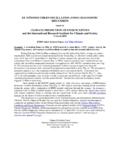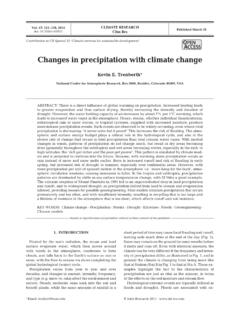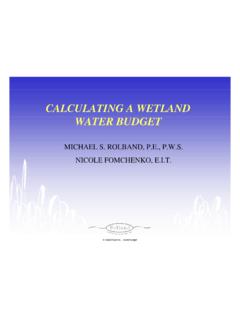Transcription of Andrew Mather1 and Andre Theron2 - CFOO: Home
1 DRAFT. RECENT EXTREME EVENTS ALONG THE COAST OF SOUTH AFRICA. Andrew Mather1 and Andre Theron2 . 1. Contact person 2. CSIR. ABSTRACT. INTRODUCTION. The coast of South Africa is continually exposed to hazards from the sea, which threaten the well-being of coastal communities through loss of infrastructure and services, and have important and long-lasting social, economic and environmental implications. In recent years, extreme events from the sea have caused much damage all along the coast, and a state of emergency has had to be declared in the worst affected areas. The unfortunate experiences of 2007 and 2008 all around the coast have now been repeated in 2011 in the southern and eastern parts of the country. Civil authorities are concerned to know whether these recent extreme events are a foretaste of what the future might hold under climate change. In such circumstances, they also wish to learn from these recent events so as to better cope in the future, and to build resilience against any increase in these hazards from the sea onto the coast.
2 After providing the context of hazards and marine drivers along the coast of South Africa, an overview is given of recent intensification of extreme sea levels and wave events, and an assessment of the prospects for the future is made. Observations of two recent extreme events are detailed, and the lessons that can be learnt from the experiences gained from these events are enumerated. The paper ends with recommendations for the development of a Coastal Hazard Exposure Classification along the coast of South Africa. HAZARDS IN CONTEXT. Indicators of coastal vulnerability almost all relate to parameters that measure erosion and inundation along the coast (Theron et al 2010), and the main drivers are waves and sea water levels (Van Ballegooyen, Theron & Wainman (2003)). The focus on inundation and erosion leads to the identification of seven variables (coastal 1. relief, lithology and landforms, and relative changes in sea level, shoreline movement, tidal range and exposure to large waves) for hazard assessment.
3 On the South African coast, beaches, estuaries and lagoons can be identified as potentially high risk environments because of their unconsolidated soft sediments, low relief and wide inland exposure. It should be noted that such areas account for more than 50%. of the South African coast, and these sections of coast are generally eroding rather than accreting (Tinley, 1985). Relative changes in sea level along the South African coast are consistent with global sea level trends, with little evidence of any appreciable local land subsidence. Tides around the South African coast are remarkably uniform, with a meso-tidal range of just over 2 metres and generally weak tidal currents all around the coast. By contrast, the wave climate is robust and large waves can penetrate right up to the coast everywhere. Statistics of significant wave height (the average of the one-third biggest waves measured in a twenty minute period) exceed 4 metres for 10% of the time and reach 8 metres annually, in deep water along much of the coast of South Africa.
4 Such large waves possess considerable erosive power and, if coastal defences are breached, the land behind is easily inundated. INTENSIFICATION OF HAZARDS. Extreme inshore sea water levels Significant drivers of high inshore sea water levels are tides, wind set-up, hydrostatic set-up, wave set-up and, in future, sea-level rise (SLR) due to climate change (Theron, et al 2010). These drivers all affect the still-water level at the shoreline. The drivers/components of extreme inshore sea water levels most significant to the Southern African context are the tides (South African spring tides are about 1 m above mean sea level (MSL), but reach up to + m MSL in Mozambique), potential SLR, and wave run-up. Theron (2007) has estimated that in the South African setting during extreme events, these components could each contribute additional amounts (heights) of between about m to m to the inshore seawater level. Note that potential additional impacts of climate change ( more extreme weather events) on wind-, hydrostatic- and wave set-up are not included in the above.
5 2. Recent observations from satellites, very carefully calibrated, are that global sea level rise over the last decade has been + +/- mm/y (Rahmstorf et al, 2007)). The IPCC AR4 Report (IPCC, 2007) concludes that anthropogenic warming and sea level rise would continue for centuries due to the timescales associated with climate processes and feedbacks, even if greenhouse gas concentrations were to be stabilised. Comparisons between about 30 years of South African tide gauge records and the longer term records elsewhere, show substantial agreement. A recent analysis of sea water levels recorded at Durban confirms that the local rate of sea level rise falls within the range of global trends (Mather, 2007). Present South African SLR rates are: west coast + , south coast + , and east coast + (Mather et al. 2009). The probability of sudden large rises in sea level (possibly several metres) due to catastrophic failure of large ice-shelves (Church and White, 2006) is still considered unlikely this century, but events in Greenland (Gregory, 2004) and Antarctica (Bentley, 1997; Thomas et al, 2004) may soon force a re-evaluation of that assessment.
6 In the longer term the large-scale melting of large ice masses is inevitable. Recent literature give a wide range of SLR scenarios, but most physics/process based projections for 2100 are in the m to 2 m range (Rossouw and Theron, 2009; Nicholls and Cazenave, 2010; Palmer et al. 2011). 3. Figure : Measured and projected sea level rise over the 20th and 21st centuries. The red curve is based on tide gauge measurements, the black curve uses the altimetry record from 1993-2009, and the shaded light blue zone represents IPPC AR4 projections. Vertical bars are semi-empirical projections. (Nicholls and Cazenave, 2010). The drivers of inshore water levels should not be confused with the added effect of wave run-up which, in the South African context, can reach much higher elevations. Wave run-up is the rush of water up the beach slope beyond the still-water level in the swash zone. According to surveyed elevations (Mather et al. 2011), maximum run-up levels on the open Kwazulu-Natal (KZN) coast near Durban during the March 2007 storm (which coincided with the highest tide of the year) reached up to about + m MSL.
7 Note that wave set-up and run-up are both accounted for in these levels. Around Southern Africa, wave run-up is thus clearly the dominant factor, which may be considerably exacerbated by tides and future SLR (Mather 2011). 4. Wave climate Much research is being done at a global level to determine if the wave climate is changing. Mori et al. (2010) examined the oceans using a General Circulation Model (GCM) and they found from their analysis clear regional dependences of both annual average and also extreme wave heights from present to future climates. The results highlighted that the future wave climate is predicted to increase at both middle latitudes and the Antarctic Ocean but reducing at the equator. Preliminary findings indicate that there may be long-term trends in regional metocean climates, while sea level rise alone will greatly increase the risks and impacts associated with extreme sea-storm events (Theron, 2007). The regional variation in the global wave climate was demonstrated by Mori et al.
8 (2010), who predicted that the mean wave height might generally increase in the regions of the mid latitudes (both hemispheres) and the Antarctic ocean, while decreasing at the equator. Their study was based on simulating future trends. Further evidence of a general wave height increase in the northern Atlantic, along the North American East coast was provided by Wang et al. (2004). Komar and Allan (2008) also found an increase in the wave height generated by hurricanes along the East coast of the United States using wave data from the National Data Buoy Center (NDBC) wave buoy data. Investigations done by Ruggerio et al. (2010) with buoy data, also indicate increasing storm intensities along both the West and East coast of Northern America. There are significant similarities in the general wave climate of the northern and southern hemispheres if comparisons are made between equivalent northern/southern hemisphere latitudes (Rossouw and Rossouw 1999).
9 Thus, general changes in northern hemisphere wave climate could be expected to be mirrored by similar wave climate changes at equivalent latitudes. Such changes in the regional metocean climates are expected to have significant impacts on local coastal areas. It is therefore important to also investigate possible future climatic changes off the southern African coastline as well as the expected associated impacts (Theron, 2011). As can be anticipated, a more severe wave climate (or indirectly a more severe oceanic wind climate ) will have greater impact on run-up and flooding levels and will thus necessitate the prediction of future trends in the wave climate . Although the available wave record is shorter than ideally required to determine long-term trends, 5. a preliminary analyses was conducted (Theron et al 2010). It was found that the annual mean significant wave height (H m0) and corresponding standard deviation for the wave data set collected off Richards Bay and the annual mean wave height (Hm0).
10 For the long-term data set, collected offshore of Cape Town, indicate no real progressive increase. This may appear to contradict the findings of the IPCC as presented in PIANC (2008). However, the South African results may reflect a regional aspect of the impact of climate change. Although the averages appear to remain constant, there seems to be some change in the individual storms (Theron et al 2010). For example, considering the peaks of individual storms during the more extreme winter period (June to August), an increasing trend of about m over 14 years is observed (Figure ). The trend may be indicative of a significant increase in the storminess over the next few decades. It is also worth noting that the opposite occurs during summer: there is a general decreasing trend over the last 14 years with regard to individual storms. Offshore Cape Town - Winter Individual storm above 5 % exceedance value ( m). 12. 10. 8. Hmo (m). 6. 4. 2. 0. 94. 95. 96.






